Jules Oppert was born 200 years ago
22 June 2025
Jules Oppert, one of the four scholars who, in 1857, deciphered the cuneiform characters transcribing the Akkadian language, was born on 9 July 1825.

The Collège de France is paying tribute to him with an exhibition entitled ‘Jules Oppert and the discovery of Mesopotamia (1850-1905)’ and a symposium entitled ‘Jules Oppert (1825-1905) and Assyriology in his time’, of which the proceedings will soon be available online.
Born in Hamburg to a Jewish broker, Jules Oppert studied law, Sanskrit and Arabic in Heidelberg, Bonn and Berlin before completing his doctoral thesis on Indian criminal law in Kiel in 1846. However, university chairs in Germany were closed to Jews. Already interested in cuneiform characters and having just published his first article on the phonological system of Old Persian, at the age of only 22, he emigrated to France and became a German teacher at the lycée in Laval, and then in Reims.
On 8 August 1851, the National Assembly approved a grant of 70,000 francs for the Scientific Expedition to Mesopotamia and Media, as well as 8,000 francs to resume excavations at Khorsabad, a site explored by Consul Paul-Émile Botta in 1843 and 1844. The Mesopotamia and Media mission, led by Fulgence Fresnel, former French consul in Jeddah, included two other members: Félix Thomas, architect and painter, and Jules Oppert, an orientalist. Oppert's correspondence, preserved at the Institut de France, offers a vivid account of the expedition and the generational tensions between the head of the mission and the two members, who were 20 and 30 years his junior.

On his return to France in July 1854, Jules Oppert set about publishing a very detailed report on the Mesopotamia mission, in which he described the progress he had made in understanding the cuneiform inscriptions. This work was also enhanced by a mission to the British Museum in London in 1855, where he was able to study cuneiform tablets that had belonged to the library of Ashurbanipal in Nineveh. He was given photographs of a number of these tablets taken by Roger Fenton, who practised this new art form.
Naturalised French in 1856, Jules Oppert took part the following year – alongside three Britons, Henry Rawlinson, Edward Hincks and William Talbot – in the test organised by the Royal Asiatic Society in London, which officially confirmed the deciphering of Akkadian cuneiform on 25 May. He published his work on the Assyrian language and cuneiform texts on a regular basis and completed his Sanskrit grammar in 1959. He assumed that the cuneiform script adopted by the Assyrians was originally designed by a population speaking a non-Semitic language, which he identified in 1869 as the Sumerian language.

Oppert was one of those erudite scholars who mastered an impressive number of languages and wrote to the Emperor that he would like to have a Chair in comparative philology where he could teach ‘Zend, Persian, give courses on Italic languages [...] and Sanskrit’. He had to wait until he was almost forty to obtain the position of his dreams, in 1864, at the École des Langues de la Bibliothèque Impériale.
In fact, recognition of Jules Oppert's work was slow in coming. After four unsuccessful attempts, he became the first professor of Assyrian philology and archaeology at the Collège de France in 1869. He was elected to the Académie des Inscriptions et Belles-Lettres in 1881, at the age of 56. Numerous foreign academies also recognised the work of this scholar by appointing him as a correspondent or member, in Germany, Italy, Russia, Hungary and Prussia.
Although he gradually lost his sight, Jules Oppert continued to publish, tirelessly translating all types of cuneiform texts and working on subjects as diverse as chronology, historical geography, law, astronomy and eclipses, the calendar, weights and measures, and Assyrian and Sumerian cuneiform signs. It is therefore fitting that the Collège de France should honour his memory in this way.


